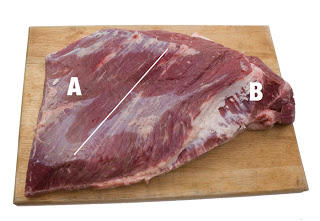Brisket would be #13 in the pic below with one on each side
[font=Arial,Verdana,Helvetica,sans-serif]Brisket is cut from the breast section of a side of beef. Each beef carcass renders only two whole briskets.[/font]
[font=Arial,Verdana,Helvetica,sans-serif]According to the
USDA Institutional Meat Purchasing Standard (IMPS), a beef brisket as it's cut from a side of beef "includes the anterior end of the sternum bones, the deep pectoral, and the supraspinatus muscle. Evidence of the cartilaginous juncture of the 1st rib and the sternum and the cross section of 4 rib bones shall be present." You'll never find this bone-in brisket in the meat department of a U.S. supermarket.[/font]
[font=Arial,Verdana,Helvetica,sans-serif]The whole brisket you'll buy for barbecue is what the IMPS calls "beef brisket, deckle-off, boneless." The IMPS defines it as follows: "All bones and cartilage shall be removed. The deckle (hard fat and intercostal meat on the inside surface) shall be removed at the natural seam exposing the lean surface of the deep pectoral muscle. The inside lean surface shall be trimmed practically free of fat." The word "intercostal" refers to meat between the rib bones.[/font]
[font=Arial,Verdana,Helvetica,sans-serif]The deep pectoral muscle (the "inside lean surface") is commonly referred to as the
brisket flat, while the supraspinatus muscle is commonly known as the
brisket point.[/font]
[font=Arial,Verdana,Helvetica,sans-serif]Contrary to popular belief, the deckle is not the same thing as the brisket point. Rather, it's the fat and muscle that attach the brisket flat to the rib cage.[/font]
[font=Arial,Verdana,Helvetica,sans-serif]The flat is just that: Sort of a flat, rectangular piece of meat that makes up the majority of the whole brisket. This is the portion that is
sliced across the grain and served on a plate or in a sandwich. You've probably seen the flat in the meat case at the supermarket, separated from the point and with most fat removed, ready for braising in the oven.[/font]
[font=Arial,Verdana,Helvetica,sans-serif]The point is a lump of meat that partially overlaps one end of the flat. It is quite fatty on its surface as well as within the meat. It also contains a lot of connective tissue between the meat fibers. It can be sliced, but its loose texture after cooking makes it a better choice for
chopped brisket sandwiches or
burnt ends.[/font]
[font=Arial,Verdana,Helvetica,sans-serif]The flat and point are separated by a very thick vein of fat running between them. This fat extends over the entire surface of the flat, becoming thinner at the end opposite the point. This layer of fat is sometimes referred to as the "fat cap". Thick fat may also wrap around one edge of the brisket flat, especially near the point.[/font]
[font=Arial,Verdana,Helvetica,sans-serif]From an anatomical perspective, the brisket flat is the "deepest" portion of meat and is attached to the rib cage, while the brisket point sits on top of the flat and is nearest the surface.[/font]
[font=Arial,Verdana,Helvetica,sans-serif]Still confused about what's the flat and what's the point? Here's an easy way to orient yourself to a whole brisket: One side of the brisket has a large area with essentially no fat on it. With the fat-free side facing down, the flat is on the bottom and the point is facing up at the high end of the brisket.[/font]
[font=Arial,Verdana,Helvetica,sans-serif]The grain of the meat in the flat and point run almost perpendicular to each another. As a result, the two sections should be
separated after cooking and dealt with separately.[/font]







